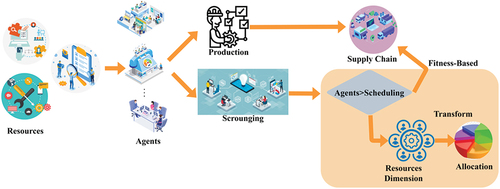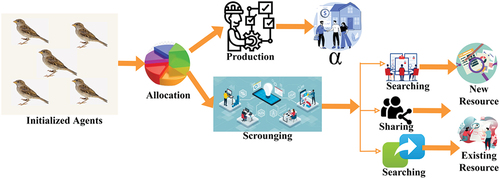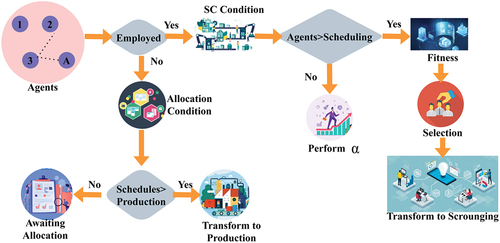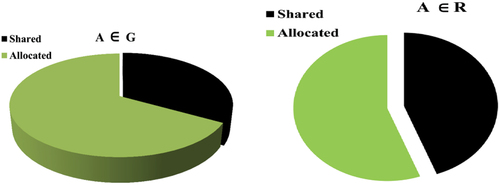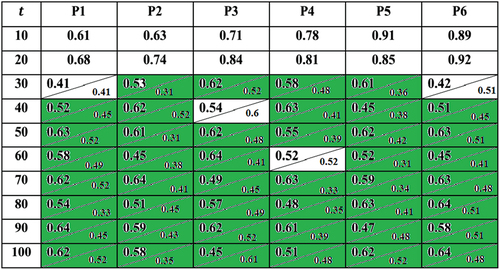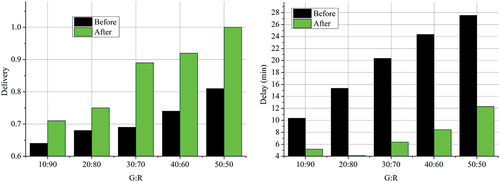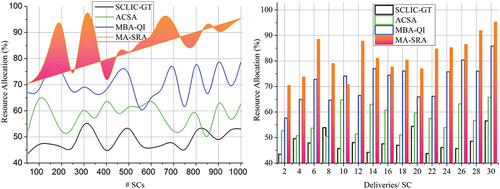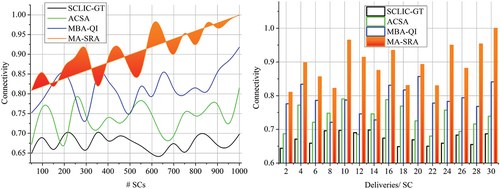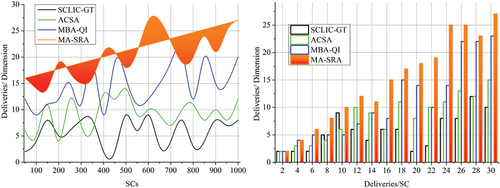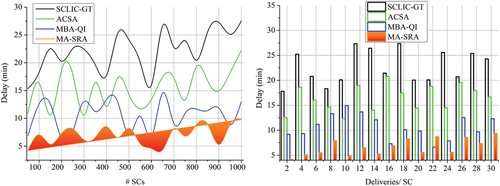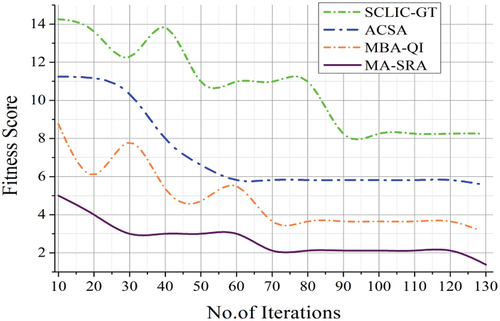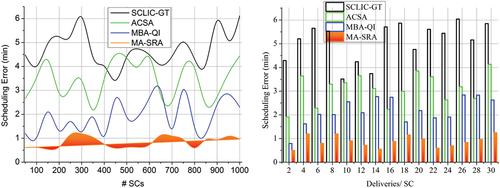 ?Mathematical formulae have been encoded as MathML and are displayed in this HTML version using MathJax in order to improve their display. Uncheck the box to turn MathJax off. This feature requires Javascript. Click on a formula to zoom.
?Mathematical formulae have been encoded as MathML and are displayed in this HTML version using MathJax in order to improve their display. Uncheck the box to turn MathJax off. This feature requires Javascript. Click on a formula to zoom.ABSTRACT
Logistics resource allocation depends on the precise scheduling of Supply Chain (SC) agents. Coordination of management across all sites, products, and production divisions is essential for effective scheduling. For multi-agent systems in heterogeneous SCs, it is crucial to have a prior understanding of production, delivery, and connectivity. Hence, an innovative meta-heuristic optimization inspired by sparrow behavior is introduced as multi-agent-based scheduling and resource allocation (MA-SRA) to resolve delivery delays and errors during delivery in logistic SC management. Allocating resources efficiently and creating workable schedules in an SC with multiple agents are the primary significant problems focused on in this research. The MA-SRA algorithm provides an achievable solution to the problem of optimizing logistics operations by combining precise scheduling with production balance and multi-agent searchers. If the scheduling operations are inadequate, sparse agents are repurposed for production based on fitness. This maintains balance and connectivity by adjusting agent ratios. Delays are minimized, and connectivity is maximized because no adjustments need to be reversed. The research findings show that the proposed approach improves operational efficiency and brings significant advantages to the industry in terms of enhanced allocation of resources, connectivity, delivery efficiency, and fewer delays and scheduling errors.
Introduction
Logistics resource allocation is a process that allocates resources based on organizational strategies and functions. The actual aim of logistics resource allocation is, to allocate limited resources to satisfy the demands of an organization (Zou, Dessouky, and Hu Citation2021). The logistic resource allocation technique is commonly used in various fields to improve the efficiency of data management systems (Diaz, Behr, and Acero Citation2022). Supply Chain Management (SCM) is a network that organizes the resources and data to fulfill users’ needs. Various applications and organizations use SCM-based logistics resource allocation (Zhao, Hong, and Lau Citation2023). An agent-based analytical approach based on SCM is used for the resource allocation. The rescheduling location challenge for improving the production can be enhanced with the help of meta-heuristic optimization algorithms like Particle Swarm Optimization (PSO) and Non-Dominated Ranking Genetic Algorithm (NRGA) to improve the allocation process (Sahebi et al. Citation2024). Modern logistics organizations’ investment capacities are severely lacking in meeting the demands of the SC’s extremely fast evolution (Fu et al. Citation2022). An auction-based resource allocation framework is also used in various applications. The actual problems and challenges are identified using SCM, which minimizes the energy consumption ratio in the computation process. The auction-based framework improves the quality and efficiency level of the resource allocation process (Trang and Li Citation2023; Wu et al. Citation2023).
Modern logistics requires managing SC distribution locations through extensive computational tests that show mixed-integer linear modeling and a reinforcement model-based hyper-heuristic scheme for efficiently assigning tasks and route planning of many resources in e-commerce warehouses (Li et al. Citation2024). The multi-agent supply chain is used for the logistics resource allocation process. The supply chain aims to provide customers with a reliable resource allocation process (Goli, Ala, and Mirjalili Citation2022). A Mixed Integer Non-Linear Programming (MINLP) approach based on a multi-agent supply chain is widely used for resource allocation. The MINLP uses an Adaptive Genetic Algorithm (AGA) to detect the necessary features and priorities to perform tasks in an application. A conflict-free routing procedure and schedule for central controlling area multi-agent aircraft that will enhance runways productivity and safety, confirmed by modeling and data from the real world (Zhang et al. Citation2024). The detected data provides the optimal information for the logistics resource allocation process. AGA is mainly used to minimize the error ratio in the data classification process (Bui et al. Citation2023). The MINLP approach increases the allocation systems’ overall performance and feasibility range. Information Technology (IT) based multi-agent method is also used for the logistics resource allocation (Queiroz et al. Citation2022). The IT identifies the relevant information from the database, reducing the identification process’s latency. The IT-based framework enhances the efficiency and reliability level of the logistics resource allocation process (Altay et al. Citation2023).
Meta-heuristics optimization is an approach that does not rely on the problem in the systems. The meta-heuristic optimization is commonly used to guide the process of performing tasks in an application (Wasswa et al. Citation2023). The meta-heuristic optimization solves optimization problems using traditional techniques. The meta-heuristic optimization is used for logistic resource management systems. The actual goal of meta-heuristics is to recommend optimal plans for the resource management process (Queiroz et al. Citation2022). A meta-heuristic optimization algorithm-based framework is used for the logistic resource management process. The optimization algorithm schedules the resources available in the database (Tirkolaee, Goli, and Mardani Citation2021). The optimization problems are detected and eliminated using a meta-heuristic optimization algorithm that reduces the allocation process’s error ratio. The meta-heuristic algorithm-based method is used for logistic resource management (Issaoui et al. Citation2021). An ordered weighted averaging (OWA) approach is implemented to minimize the computational cost range in the allocation process. OWA enhances resource management’s efficiency and accuracy level, improving the systems’ performance ratio (Xu et al. Citation2021).
Motivation, Research Gap and Contribution
This research addresses logistic supply chain management issues related to delivery delays and errors using a meta-heuristic optimization algorithm called SSA. This research sought to integrate multi-agent searchers, precise scheduling, and production balance to decrease delays in delivery and connectivity concerns to address the shortcomings of existing research approaches, Developing a meta-heuristic optimal process for allocating resources in logistics, incorporating accurate scheduling strategies, and performing data-driven evaluations to evaluate the coherence of the proposed optimization are the main contributions of this research.
Research Importance
Real-world systems, especially logistics management, depend on this research investigation. It handles crucial issues like the allocation of resources and delivery optimization by using a unique SSA optimization method. SC operations need these solutions to improve efficiency, lower costs, and satisfy customers. Optimizing logistics procedures reduces transportation-related carbon emissions, which improves the environment. This research promotes economic sustainability and environmental responsibility, making it relevant and meaningful for real-world logistical systems.
Research Novelty
This study contributes to the existing literature by tackling logistic SC management constraints related to delivery delays and errors using a meta-heuristic optimization method, MA-SRA, that draws inspiration from sparrow behavior. This study takes a novel approach to logistics operations optimization by integrating multi-agent searchers, accurate scheduling, and production control to maximize scheduling performance and allocate resources efficiently.
The contributions of this article are listed below:
To develop a novel meta-heuristic optimization method for resolving the scheduling and allocation of resources problem in logistic supply chain management.
Integrating efficient scheduling and balancing production and delivery through a multi-agent framework to minimize delivery delays and connectivity issues.
To validate the proposed optimization’s consistency through comparative assessment using external sources and relevant performance metrics.
Related Works
Lucht et al. (Citation2021) developed a model-based approach for planning the quality assessment process in production logistics. The main goal of the developed approach is to identify the actual planning quality range of the systems. The Key Planning Quality Indicators (KPQI) are used here to evaluate the planning quality of the logistics. KPQI minimizes the latency in the computation process. The developed approach improves the dynamic range of the systems in the market environment. The approach ignores dispersion characteristics, affecting schedule reliability and the mean value.
Feng et al. (Citation2020) designed a logical time petri set-based analysis model for logistic chains. The designed model calculates the time-related property that is presented in the database. The actual time interval ratio and transition details are calculated based on petri sets. The designed model uses an analysis process to predict the exact quality and time-interval level. The designed model enhances the overall efficiency and performance range of logistic chains.
Zhang et al. (Citation2020) introduced a new Supply Chain Logistics Information Collaboration (SCLIC) strategy using an evolutionary game theory. The evolutionary game theory is mainly used here to analyze the benefits and factors for manufacturing functions. The introduced strategy reduces the complexity of the identification process. Experimental results show that the introduced strategy maximizes the efficiency and feasibility ratio of the applications. The premise of linear market demand may not fully convey the complexity of uncertain real-world market dynamics.
Xiong et al. (Citation2023) proposed an adaptive adjustment model for Task Scheduling and Resource Allocation (TSRA) in cloud manufacturing systems. The proposed model uses the Multi-Stakeholder Interest (MSI) to identify the important advantages used for further processes. Normal and conflict information is gathered to minimize the complexity of the TSRA process. The proposed TSRA model improves the effective range of cloud manufacturing systems.
Kang et al. (Citation2021) presented an auction-based cloud service allocation method for Logistics Product Service Systems (LPSS). A Multi-unit Vickery (MV) auction is used here to address the logistics resources required for resource allocation. MV also identifies the effective factors and resource allocation patterns that reduce the computation process’s latency. The proposed method achieves high accuracy in the allocation process, enhancing LPSS’s performance level.
Boskabadi et al. (Citation2022) developed a fuzzy mathematical model for a distribution network. The main aim of the proposed model is to reduce the total network cost of the system. Human resources are used here to provide necessary information for the quality assessment process. The proposed model maximizes the products’ overall profits, increasing the evaluation process’s accuracy. The rest of the related works are summarized in .
Table 1. Comparative summary of the related works.
Most of the literature on SC logistics is concerned with optimization strategies; however, it fails to deal with issues such as evaluating scheduling quality, calculating attributes related to time and the best ways to apply evolutionary approaches. In addition, there has been limited research into efficient optimization algorithms for practical logistics issues, especially those involving decision-making and uncertain circumstances. Thus, advancing methodologies offer a chance to improve the effectiveness of SC logistics operations and fill the deficiencies. provides the list of notations and assumptions employed in this research.
Table 2. Notations and assumptions.
Multi-Agent-Based Scheduling and Resource Allocation Optimization
Resource allocation in supply chain management shows the procedure of allocating the restricted accessible resources fittingly to satisfy the demands. Resource allocation in logistics is the procedure of allotting and maintaining the expedients in a way that holds up the supply chain’s deliberated planning goals. Assigning continuous work to allocate resources improves the perfect delivery and the diversified relations between the places, products, and manufacturing units. Multi-agents-based diversified SC management needs prior knowledge of execution, delivery, and connectivity. If any alterations are made to the features as mentioned above, they are to be notified and informed to avoid time delays and improper deliveries. The optimization problems in logistics management are best tackled by meta-heuristic algorithms such as the SSA because of their speed and efficiency in exploring complex solutions and finding near-optimal solutions. The meta-heuristics technique is a process based on the heuristic method, which does not count on the type of acquired problem. The sparrow search algorithm is an effective improvement technique that imitates sparrows’ sagacity pasturing and anti-pillaging behavior. This algorithm is used for the fast confluence and high precision within the given population of procedures. This article introduces a meta-heuristic optimization using a sparrow search algorithm named Multi-Agent-Based Scheduling and Resource Allocation (MASAP).
Resource Allocation in Supply Chain Management
Supply chain management controls the drift of goods, data, and resources related to a product, from acquiring raw materials to delivering the product to the user at its final destination. The combination, procedures, procuring, and dissemination are vital characteristics of SC management. The SC management encircles the combined planning and extortion of procedures needed to enhance the flow of resources and functions. The main objectives of supply chain management are to plan, source, make, and deliver the needed products and return the goods to the users. presents the proposed optimization process.
In this procedure, the sparrow agents are extracted from the resources for the two distinct operations of production and scrounging. The production agents are used for resource allocation for supply chain management, and the scrounging agents are used to share resources. In production operations, both the production agents and the scrounging agents occur. However, in the scrounging process, only the sharing agents are used to schedule the resources for the supply chain management. If the agents are less than the scheduled operations, the scrounging agents are temporarily transformed into production agents. The existing production and transformed agents are utilized according to their fitness. Fitness can be identified based on the highest resource dimension. Depending on the joined or transformed agents, the resources are allocated to the SC management. This process helps reduce connectivity issues and time delays. Therefore, the modifications need not be reversed from the scrounging agents, and therefore, it confines delay and maximizes connectivity. The resources are first identified, then the sparrow agents are extracted from the acquired resources. The sparrow agents are extorted from the resources using the sparrow search algorithm.
The resources are acquired for the SC management allocation procedure, and then the sparrow agents are extracted from the resources. Then, it is used in production and scrounging operations. The agents imitate the features of the sparrow as they help share resources with SC management. The acquired resources lead to further procedures to eliminate the connectivity issues and the time delays.
Multi-Agent-Based Scheduling Efficiency
The agent helps in the sharing of the attained resources to the SC management directly or by transforming and then the resource dimensions are identified. The attained resources are verified whether they can be allocated to the SC or not then further procedures are taken for the resource allocation operation. These are the resources that help in the production and scheduling procedures for the SC management. Sparrow agents are useful in the production of sources with high accuracy and with fast confluence. It also exhibits the perspicacious pasturing and the devastating features which help in the perfect resource allocation procedures. The process of extracting the agents from the appropriate resources by using the sparrow search algorithm is explained by the following EquationEquations (1)(1)
(1) and (Equation2
(2)
(2) ) given below:
Where is denoted as the acquired resources,
is represented as the checking procedure,
is denoted as the extracting the sparrow agents,
is denoted as the sparrow search algorithm used in the extraction procedure,
is denoted as the characteristics of the agents,
is represented as the confluence produced by the sparrow agents. Now two distinct operations are taking place such as production and the scrounging process. The scrounging agents are responsible for scheduling the resources. The agents present in the scheduling or sharing resources procedure can only help in sharing. It cannot be responsible for the production procedure of the resource allocation. This can only be in the scrounging procedures by sharing the resources to further operations of resource allocation to the SC management. In this procedure, the sparrow agents are helping in scheduling the resources and also within the time used to transfer the resources to the user. For perfect precision and high confluence, the sparrow is selected for the source allotting operation to the SC. This procedure along with the production process helps in the identification of the resource dimension and also in the transformation process. The scrounging process is diagrammatically illustrated in .
The scrounging process helps in the sharing of the acquired resources to the further process and with the production process. It avoids the connectivity issues happening in the resource allocation process. The scrounging agents cannot be transformed into the production agents but they can transform temporarily and again it changes into the scrounging agents. Those agents can help identify the resource dimension and resource fitness. The scrounging and the production agents help make the resources for the SC management with the acquired resources (). The resources are consolidated by using these scrounging agents and the resources are extorted to the SC by using the production agents. The scrounging agents can make the resources to the further procedures according to the attained resources and the sparrow agents. The processes of sharing the resources by using the scrounging agents are explained by the following EquationEquations (3)(3)
(3) and (Equation4
(4)
(4) ) given below:
Where is denoted as the scrounging agents,
is represented as the sharing resources by the scrounging agents,
is denoted as the scheduling operation of the agents,
is denoted as the outcome of the scrounging process,
is denoted as the outcome of the scheduling procedure done by the scrounging agents,
is represented as the operation of managing the time during sharing the resources. The production agents help with the resource allocation procedure for SC management. Here, the both sharing agents and the production agents are working on the production procedure for the apportionment of the acquired resources. This agent makes the acquired resources available for the SC without time delays and connectivity issues. By using the sparrow agents, the resources are allocated, and the resource dimension can be determined along with the scrounging process. The production and scrounging operations occur from the agents extracted from the received resources. One is used for production, and the other is for sharing resources.
The production operation is responsible for allocating resources to SC management. Using both the sharing agents and the production agents, the sources are allocated to the users without any time lags or connectivity issues. Without transforming any of the agents, the resources are allocated to the SC in this production operation, and the fitness can be determined based on the resource dimension. Fitness is based on the resource dimension achieved by the single sparrow agent and then it is used in the resource allocation procedure with the scrounging process. By using operations production and scrounging, the resources are allocated to SC management without any issues or time lags. The process of allocating the resources for the SC management in the production procedure is explained by the following EquationEquations (5)(5)
(5) and (Equation6
(6)
(6) ) given below:
Where is denoted as the production operation,
is represented as the resource allocation by the production procedure,
is denoted as the outcome of the production procedure by allocating the resources to the SC management. Now, if the scheduling agents are greater than the scrounging agents, they are used to temporarily transform as the production agent for the resource allocation process. The scrounging agents are transformed temporarily as the production agents for resource allocation, and then they are used in that procedure based on resource dimension.
Integration of Production and Scrounging Operations
The scrounging agents’ transformation as production agents is temporary as it changes into its feature after the process. It cannot be done permanently, and then the dimension of the resources should be identified for the fitness determination. The transformation process of the agents is illustrated in .
If the scrounging agents are lesser than the scheduling agents, then the transformation procedure takes place temporarily for the resource apportionment procedures. It is also used to determine the resource dimension and the fitness of the resource. The efficiency of the single sparrow agent can be identified through this transformation process. The agents are transformed into production agents to allocate resources without any comparability issues and time lags. These operations are done based on the high fitness from the resource dimension of the single sparrow agent (). The agent transformation procedure helps in executing the appropriate resources for SC management. Based on the high fitness and the resource dimension, the transformation of the scrounging agents takes place to allocate the resource procedure. The process of transforming the scrounging agent into a production agent for the resource allocation procedure is explained by the following EquationEquations (7)(7)
(7) and (Equation8
(8)
(8) ) given below:
Where is denoted as the agent transformation operation,
is represented as the results of the transformation procedure. The agent transformation depends on the high fitness from the resource dimension.
Sparrow Search Algorithm for Optimization
The resource dimension is identified from the single sparrow agent during allocation. The fitness is determined from the high resource dimension of the agents. This is identified when the agent allocates precise resources to the SC on time without any issues or time lags. The high resource dimension exists, and then fitness occurs. The fitness is reckoned depending on the maximum resource dimension expanded by a single sparrow agent from the start of the procedure. The efficiency of the sparrow agent during the resource allocation operation is observed from the initialization, and the high fitness is identified depending on the dimension of the sources. The fitness estimation process is illustrated in .
The agent transformation is consummated based on high fitness according to the source proportion. The fitness-based transformation of the agents helps in the resource allocation procedure for SC management. The agents with the highest fitness can transform into production agents for further procedures, and then the proportion of the resources is determined for the fitness identification procedure. Then, from this outcome, the sources are allotted to the SC, and the transformed agents are turned into their real scrounging agents (). The process of determining the fitness based on the resource dimension for the agent transformation operation is explained by the following EquationEquations (9)(9)
(9) -(Equation11
(11)
(11) ) given below:
Where is denoted as the fitness identification procedure,
is denoted as the highest resource dimension,
is represented as the resource proportion expanded by the single sparrow from the initialization of the process. Now, the resources are allocated to the supply chain management by considering the transformed agents and the existing production agents. The initial production and transformed production agents are utilized based on fitness. This helps in the precise resource allocation based on the sparrow agents’ high fitness and resource dimension. The procedure of resource allocation based on the transformed and the production agents are explained by the following EquationEquations (12)
(12)
(12) -(Equation14
(14)
(14) ) given below:
Where is denoted as the consideration of the initial production agents and the transformed agents,
is represented as the resource allocation based on the high fitness of the agents to the SC management. This process helps eliminate connectivity issues and reduce time lags during the resource allocation process. The sparrow search algorithm helps allocate the precise sources for the SC with the sagacity pasturing features. The production and scrounging agents help allocate resources and schedule resources for supply chain management. An overview of the Sparrow Agent Transformation Process is presented in .
Table 3. Overview of sparrow agent transformation process.
External Data Analysis
The proposed optimization approach is analyzed using the information in (Kalganova, Tatiana; Dzalbs, Ivars (2019): Supply Chain Logistics Problem Dataset. Brunel University London. Dataset. https://doi.org/10.17633/rd.brunel.7558679.v2). The information of a complete order to delivery is recorded using 7 tables for location, freight charges, products/production unit, supply ports, order list, consumers, and local costs. A maximum of 1541 records are used for analyzing the optimization approach’s performance. First, the information for several SCs is generated as agents to validate the production and scrounging processes. presents the supply chain connectivity process based on average customers (deliveries) at time .
The number of agents relies on the deliveries that are further confined if the connecting points are the same. If a connecting point is identified in common then one production agent is converted into scrounging or vice versa. This improves distribution/production unit identification. Both cases increase the chance of connectivity improvements and resource allocations (). In the first analysis, the actual agents required and the converging agents are tabulated in .
Table 4. Summary of required agents and convergence instances.
The convergence instances presented in requires connecting point verification. In the verification process, the actual deliveries are concatenated for improving the scheduling process due to which new improvements are made. The fitness estimation demands multiple intervals for updating agents (either scrounging/production) for preventing connectivity failures. Apart from the connectivity failures, the average resource allocated and shared by the two agents for to
instances is analyzed in .
The resource allocated and shared dynamics are validated and
such that
and
(shared) instances are exploited. As the
combination decides
and
further sharing is therefore performed using the transform. The agent transform based on
(Scrounging) or
(production) decides the chances of sharing. This varies the actual sharing converged to some point based on the common delivery point as in . Now, the transform required agents for
using the supply ports (as in the source) is analyzed with the
ratio. This analysis is presented in .
The analysis considers the transform and fitness validation for the available. Leaving out the converging points, the distribution (delivery) based allocations are performed for high
compared to
. The top values represent the
and the bottom value represents the
, considerably. If
delivery is high; no new agents are required, and
is retained; contrarily, the inverse requires new agents to be introduced or the transform (). As defined in the problem section, the connectivity and delay based on
is analyzed in . This analysis is performed before and after transform (with convergence).
The varies for the available
such that
and
and
is a varying input. Such variation is handled using
for resource allocation and delivery. Considering the
and
for the available agents, the output is collaborated for improving the deliveries. The convergence is also considered for transformation, and hence the optimization occurs (Refer to ).
Comparative Analysis
Performance in resource allocation, connection, deliveries per dimension, delay, and scheduling measurement metrics for error were used to choose the comparative metaheuristics in this research. The following methods are selected: SCLIC-GT, ACSA, and HBA-QI, to evaluate the suggested MA-SRA optimization algorithm. This evaluation aimed to determine which of these approaches was most useful for enhancing scheduling and resource allocation in a supply chain setting with many agents and to prove the superiority of the MA-SRA.
The comparative analysis is performed using the metrics resource allocation (%), connectivity (factor), deliveries/dimension (count), delay (min), and scheduling error (min). The number of SCs and the deliveries/SC are the variants in this analysis. The methods SCLIC-GT (Zhang et al. Citation2020), ACSA (Kang et al. Citation2021), and HBA-QI (Lucht et al. Citation2021) are the considered methods along the proposed optimization.
The resource allocations are productive in this procedure by using the production and scrounging distinct operations. The production agents are used for resource allocation for supply chain management, and the scrounging agents are used to share resources. The transformation procedure occurs if the scrounging agents are less than the scheduling agents. The scrounging agents are transformed temporarily as the production agents for the resource allocation and then used in that procedure based on the resource dimension. The agent transformation takes place based on the high fitness and the resource dimension. Fitness can be identified based on the highest resource dimension. Depending on the joined or transformed agents, the resources are allocated to the SC management. The initial production and transformed production agents are utilized based on fitness. This helps in the precise resource allocation based on the sparrow agents’ high fitness and resource dimension. The resource allocation is effective in this procedure ().
The connectivity is better in this process by eliminating the issues happening in the connectivity during the resource allocation process. The production agents help with the SC management resource allocation procedure. Scrounging agents help schedule and share the SC resources. Then, both the sharing agents and the production agents are working on the production procedure to apportion the acquired resources. This agent makes the acquired resources available for the SC without time delays and connectivity issues. The transformation process also takes place without initiating the issues in the allocation process, and then, based on the high fitness, the existing and transformed agents are utilized. Using those agents eliminates the connectivity issues, and then the time delays are decreased during the SC management resource allocation procedure. Scrounging operations help determine the high fitness and resource dimension based on the efficiency of the single sparrow from the initialization ().
The scheduling rate is productive in this method through the effective scrounging of distinct operations and the production procedure. Scrounging is responsible for scheduling and sharing the resources with the users. The agents present in the scheduling or sharing resources procedure can only help in sharing. Scheduling agents are greater than scrounging agents, and it is used to transform into production agents temporarily for the resource allocation process. The scrounging agents are transformed temporarily as the production agents for the resource allocation and then used in that procedure based on the resource dimension. The agent transformation procedure helps in executing the appropriate resources for SC management. Based on the high fitness and the resource dimension, the transformation of the scrounging agents takes place to allocate the resource procedure. Depending on the perfect scheduling of the resources, the source allocation is done properly with the precise information of the sources ().
The delay is eliminated in this process with the help of the perfect production of the resources to the SC management. Here the connectivity is also enhanced and the lags are reduced by the effective extortion of the agents. From the resources, the sparrow agents are extracted by using the sparrow search algorithm. The agents are better in the production and the scrounging process for the resource allocation operation to the SC. Scrounging helps in the determination of the fitness and the resource dimension of the single sparrow agent. The fitness is determined based on the high resource dimension. The fitness-based transformation of the agents helps in the resource allocation procedure for SC management. This is identified when the agent allocates the precise resources to the SC on time without any issues and time lags. The acquired resources are leads to allocate to further procedures to eliminate the connectivity issues and the time delays. By this, the delay can be reduced with the aid of production and scrounging operations ().
Scheduling errors are reduced by enhancing the efficiency of the sparrow agents extracted from the acquired resources. Sparrow agents are useful in producing sources with high accuracy and fast confluence. The attained resources are verified whether they can be allocated to the SC, and then further procedures are taken for the resource allocation operation. These resources help with the production and scheduling procedures for SC management. The scrounging operation is responsible for scheduling the resources for the SC management and sharing them without any errors and connectivity issues. In this procedure, the sparrow agents help schedule the resources and transfer them to the user within the time they are used. For perfect precision and high confluence, the sparrow is selected for the source allotting operation to the SC. The scrounging agents help make the perfect resource allocation along with the production operation by preventing scheduling errors and time lags.
The time complexity is analyzed from the iterative process for resource allocation, and scheduling optimization is given as . The memory complexity is considered from the storage demand given by the multi-agent data, and the optimization parameters are given as
. Unlike the proposed MA-SRA, cost-effectiveness is crucial and guaranteed for future scope, primarily focused on operational improvements. The runtime is influenced by SC network size, the speed at which the SSA optimization converges to a solution, and meta-heuristic technique-based computational resources.
illustrates the convergence graph demonstrating how the optimization algorithm’s fitness score evolves during iterations. The number of iterations, shown on the x-axis, refers to the number of times the algorithm has gone through the optimization procedure. The fitness score, which can be anywhere from 2 to 14, is shown on the y-axis. The optimal fitness score would decrease and converge toward a lower range while the algorithm iterates using SSA optimization. A point on the graph represents the fitness score at each iteration, showing that the algorithm’s speedy convergence and the way it optimizes helps to calculate the computational complexity. The Fitness assessment result usually begins at a high one, indicating a less-than-ideal starting point in the proposed MA-SRA compared to other existing models.
below show the improvements made to the proposed optimization compared to the existing methods on variants 1 and 2 ().
Table 5. Comparison summary of optimization improvements on variant 1.
Table 6. Comparison summary of optimization improvements on variant 2.
Allocation of resources (%), connectivity, deliveries/dimension, delay in (min), and scheduling error in terms of (min) are some of the important metrics used to evaluate MA-SRA’s performance in . These metrics offer a comprehensive assessment of its performance in logistics supply chain management by measuring its efficiency in resource utilization, network acceptance and integration, distribution operations in delivery, timely delivery, and accuracy.
Efficiency in allocating resources, connectivity, delivery performance, and elimination of delays and errors in the scheduling process are all significantly improved according to the testing results. These results prove that the MA-SRA algorithm is useful for improving logistical procedures and increasing the effectiveness of SC operations. The results objectively demonstrate how the optimization technique may help the real-time industry and its practical benefits. The MA-SRA algorithm could create cost savings, satisfy customers, and simplify SC operations.
Case Study: Implementation of MA-SRA in Pharmaceutical Supply Chain
The MA-SRA research model optimized scheduling and resource allocation in a real case study scenario in a pharmaceutical supply chain. A network of manufacturing sites, distribution hubs, and retailer pharmacies are included in the case study, which sought to enhance delivery performance and simplify the distribution of medical supplies.
Model Parameters and Units
Supply chain stages of distribution and production get a certain percentage of available resources. Connectivity is a factor that measures the degree of connectivity and effectively integrates the nodes in the supply chain to communicate with one another. The count of accurate deliveries per unit of resource dimension is recognized in terms of deliveries/dimension. Time delay (in minutes): The amount of time it takes for the delivery of medical supplies to be completed. Scheduling Error (min): Minute-by-minute change from the original schedule.
Practical Findings
Enhanced Production Efficiency: With MA-SRA in place, resource allocation became much more streamlined, and total productivity increased by 15%.
Improved Connectivity: A 20% increase in connectedness indicates that supply chain actors are now better able to coordinate and communicate with one another.
Higher Deliveries: A 25% increase in deliveries per resource dimension enables better resource use.
Delay Mitigation: Faster and more dependable supply chain operations resulted in a 30% reduction in typical delivery delays.
Reduced Scheduling Errors: A 40% decrease in scheduling errors resulted in more precise and efficient scheduling procedures.
Applying the MA-SRA research model to real-world logistics operations yields real-life advantages. as shown by the pharmaceutical SC case study. Businesses may save finances, make consumers happier, and boost SC efficiency of the supply chain by making scheduling and resource allocation as efficient as possible.
Conclusion
An innovative meta-heuristic optimization method called MA-SRA is presented in this research and inspired by sparrow behavior. It aims to fill in the gaps in SC’s logistic management. The approach improves logistics operations by merging multi-agent searchers with precise scheduling, increasing resource allocation efficiency and decreasing delivery interruptions.
The primary objective was to develop and implement the MA-SRA algorithm for resource allocation and scheduling in a multi-agent supply chain setting. Utilizing a sparrow search algorithm, the study optimized production and scrounging operations, supported by data-driven assessments and comparative analysis for validation.
Optimization of resource allocation, connection, and delivery effectiveness was greatly improved by the MA-SRA algorithm, which increased efficiency in operations, decreased costs, and promoted consumer satisfaction. Based on the research findings, this research has practical insights for managers and decision-makers, which provide direction on streamlining procedures, enhancing efficiency, and promoting organizational success. Practical solutions to key challenges associated with the logistic management of SC can be found through the use of MA-SRA. The optimization improves connectivity by 9.44%, thereby assisting with convergence problems, and decreases delays by 8.87%, according to the comparison.
The study’s limitation is that the transformation procedure may become ineffectual if the concurrent agents’ deliveries or resource-searching activities are inadequate. In such situations, the transformation could lead to inefficient use of computing resources since it takes time without providing substantial benefits for tasks like allocation of resources or search process.
Future studies should focus on improving MA-SRA’s scalability and adaptability in bigger SC networks, incorporating real-time data analysis cost-effectively, and using automated modeling approaches with hybridized decision-making.
Disclosure Statement
No potential conflict of interest was reported by the author(s).
References
- Akhtar, M., A. K. Manna, and A. K. Bhunia. 2023. Optimization of a non-instantaneous deteriorating inventory problem with time and price dependent demand over finite time horizon via hybrid DESGO algorithm. Expert Systems with Applications 211:118676. doi: 10.1016/j.eswa.2022.118676.
- Altay, N., G. Heaslip, G. Kovács, K. Spens, P. Tatham, and A. Vaillancourt. 2023. Innovation in humanitarian logistics and supply chain management: A systematic review. Annals of Operations Research 321 (1–2):1–27. doi: 10.1007/s10479-022-04952-5.
- Boskabadi, A., M. Mirmozaffari, R. Yazdani, and A. Farahani. 2022. Design of a distribution network in a multi-product, multi-period green supply chain system under demand uncertainty. Sustainable Operations and Computers 3:226–37. doi: 10.1016/j.susoc.2022.01.005.
- Bui, T. D., J. W. Tseng, H. Aminah, J. Sulistiawan, M. H. Ali, and M. L. Tseng. 2023. Causality of total resource management in circular supply chain implementation under uncertainty: A context of textile industry in Indonesia. Annals of Operations Research 1–41. doi: 10.1007/s10479-023-05200-0.
- Chavez, M. M. M., W. Sarache, Y. Costa, and J. Soto. 2020. Multiobjective stochastic scheduling of upstream operations in a sustainable sugarcane supply chain. Journal of Cleaner Production 276:123305. doi: 10.1016/j.jclepro.2020.123305.
- Diaz, R., J. G. Behr, and B. Acero. 2022. Coastal housing recovery in a postdisaster environment: A supply chain perspective. International Journal of Production Economics 247:108463. doi: 10.1016/j.ijpe.2022.108463.
- Feng, X., M. Lin, W. Liu, C. Yan, and L. Liu. 2020. Modeling and analysis for uncertainty in logistic chains based on logical time petri nets. IEEE Access 8:61665–71. doi: 10.1109/ACCESS.2020.2978940.
- Fu, J., B. Cao, X. Wang, P. Zeng, W. Liang, and Y. Liu. 2022. BFS: A blockchain-based financing scheme for logistics company in supply chain finance. Connection Science 34 (1):1929–55. doi: 10.1080/09540091.2022.2088698.
- Gao, G., Y. Che, and J. Shen. 2021. Path optimization for joint distribution of medical consumables under hospital SPD supply chain mode. Journal of Combinatorial Optimization 42 (4):866–83. doi: 10.1007/s10878-019-00506-x.
- Ghasemi, P., F. Goodarzian, and A. Abraham. 2022. A new humanitarian relief logistic network for multiobjective optimization under stochastic programming. Applied Intelligence 52 (12):13729–62. doi: 10.1007/s10489-022-03776-x.
- Goli, A., A. Ala, and S. Mirjalili. 2022. A robust possibilistic programming framework for designing an organ transplant supply chain under uncertainty. Annals of Operations Research 328 (1):1–38. doi: 10.1007/s10479-022-04829-7.
- Goodarzian, F., P. Ghasemi, E. D. S. Gonzalez, and E. B. Tirkolaee. 2023. A sustainable-circular citrus closed-loop supply chain configuration: Pareto-based algorithms. Journal of Environmental Management 328:116892. doi: 10.1016/j.jenvman.2022.116892.
- Issaoui, Y., A. Khiat, A. Bahnasse, and H. Ouajji. 2021. An advanced LSTM model for optimal scheduling in smart logistic environment: E-commerce case. IEEE Access 9:126337–56. doi: 10.1109/ACCESS.2021.3111306.
- Kang, K., R. Y. Zhong, S. X. Xu, B. Q. Tan, L. Wang, and T. Peng. 2021. Auction-based cloud service allocation and sharing for logistics product service system. Journal of Cleaner Production 278:123881. doi: 10.1016/j.jclepro.2020.123881.
- Kuo, T. C., K. J. Chen, W. J. Shiang, P. B. Huang, W. Otieno, and M. C. Chiu. 2021. A collaborative data-driven analytics of material resource management in smart supply chain by using a hybrid industry 3.5 strategy. Resources, Conservation and Recycling 164:105160. doi: 10.1016/j.resconrec.2020.105160.
- Li, K., T. Liu, P. R. Kumar, and X. Han. 2024. A reinforcement learning-based hyper-heuristic for AGV task assignment and route planning in parts-to-picker warehouses. Transportation Research Part E: Logistics & Transportation Review 185:103518. doi: 10.1016/j.tre.2024.103518.
- Lucht, T., A. Muetze, T. Kaempfer, and P. Nyhuis. 2021. Model-based approach for assessing planning quality in production logistics. IEEE Access 9:115077–89. doi: 10.1109/ACCESS.2021.3104717.
- Queiroz, M. M., D. Ivanov, A. Dolgui, and S. Fosso Wamba. 2022. Impacts of epidemic outbreaks on supply chains: Mapping a research agenda amid the COVID-19 pandemic through a structured literature review. Annals of Operations Research 319 (1):1159–96. doi: 10.1007/s10479-020-03685-7.
- Queiroz, M. M., S. F. Wamba, C. J. C. Jabbour, and M. C. Machado. 2022. Supply chain resilience in the UK during the coronavirus pandemic: A resource orchestration perspective. International Journal of Production Economics 245:108405. doi: 10.1016/j.ijpe.2021.108405.
- RezaHoseini, A., S. Noori, and S. F. Ghannadpour. 2021. Integrated scheduling of suppliers and multi-project activities for green construction supply chains under uncertainty. Automation in Construction 122:103485. doi: 10.1016/j.autcon.2020.103485.
- Sahebi, I. G., S. P. Toufighi, M. Azzavi, and F. Zare. 2024. Presenting an optimization model for multi cross-docking rescheduling location problem with metaheuristic algorithms. Opsearch 61 (1):137–62. doi: 10.1007/s12597-023-00694-5.
- Schoenherr, T., C. Mena, B. Vakil, and T. Y. Choi. 2023. Creating resilient supply chains through a culture of measuring. Journal of Purchasing & Supply Management 29 (4):100824. doi: 10.1016/j.pursup.2023.100824.
- Tirkolaee, E. B., A. Goli, and A. Mardani. 2021. A novel two-echelon hierarchical location-allocation-routing optimization for green energy-efficient logistics systems. Annals of Operations Research 324 (1–2):1–29. doi: 10.1007/s10479-021-04363-y.
- Trang, N. T. N., and Y. Li. 2023. Reverse supply chain for end-of-life vehicles treatment: An in-depth content review. Resources, Conservation & Recycling Advances 17:200128. doi: 10.1016/j.rcradv.2022.200128.
- Wasswa, J. H., H. Oundo, M. O. Oteba, H. Komakech, I. Ochola, S. Mwebaze, D. Okidi, A. Kirunda, S. Nakadde, N. O. Oteba, et al. 2023. Leveraging electronic logistics management information systems to enhance and optimize supply chain response during public health emergencies: Lessons from COVID-19 response in Uganda. Journal of Pharmaceutical Policy and Practice 16 (1):6. doi: 10.1186/s40545-023-00517-4.
- Wu, K. J., M. L. Tseng, W. H. Yang, M. H. Ali, and X. Chen. 2023. Re-shaping sustainable value chain model under post pandemic disruptions: A fast fashion supply chain analysis. International Journal of Production Economics 255:108704. doi: 10.1016/j.ijpe.2022.108704.
- Xiong, W., M. K. Lim, M. L. Tseng, and Y. Wang. 2023. An effective adaptive adjustment model of task scheduling and resource allocation based on multi-stakeholder interests in cloud manufacturing. Advanced Engineering Informatics 56:101937. doi: 10.1016/j.aei.2023.101937.
- Xu, J., X. Liu, X. Li, L. Zhang, J. Jin, and Y. Yang. 2021. Energy-aware computation management strategy for smart logistic system with MEC. IEEE Internet of Things Journal 9 (11):8544–59. doi: 10.1109/JIOT.2021.3115346.
- Zhang, Z., Y. Xue, J. Li, L. Gong, and L. Wang. 2020. Supply chain logistics information collaboration strategy based on evolutionary game theory. IEEE Access 8:46102–20. doi: 10.1109/ACCESS.2020.2978943.
- Zhang, Y., S. Zhang, Y. Zhang, and Y. Yin. 2024. A study of TMA aircraft conflict-free routing and operation: With mixed integer linear programming, multi-agent path finding, and metaheuristic-based neighborhood search. IEEE Transactions on Intelligent Transportation Systems. doi: 10.1109/TITS.2024.3385859.
- Zhao, N., J. Hong, and K. H. Lau. 2023. Impact of supply chain digitalization on supply chain resilience and performance: A multi-mediation model. International Journal of Production Economics 259:108817. doi: 10.1016/j.ijpe.2023.108817.
- Zou, H., M. M. Dessouky, and S. Hu. 2021. An online cost allocation model for horizontal supply chains. Transportation Research Part C: Emerging Technologies 122:102888. doi: 10.1016/j.trc.2020.102888.

